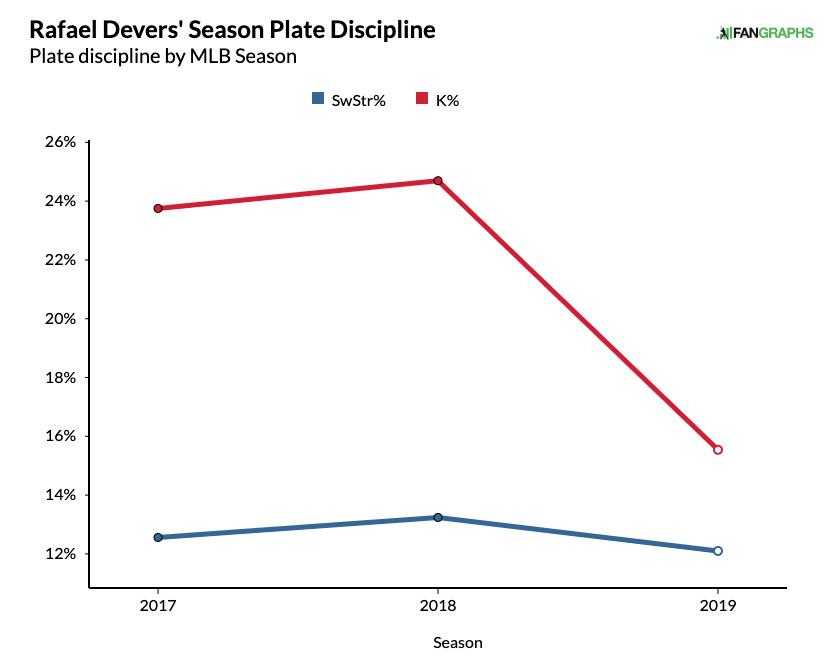
Here’s a baseball puzzle. Last year’s World Series–winning Red Sox boasted one of the best offenses in the league, scoring 0.96 more runs per game than the average team. This year’s Red Sox have seen the OPS+ for Mookie Betts, last year’s most frequent no. 1 hitter, drop by 58 points; the OPS+ for Andrew Benintendi, last year’s most frequent no. 2 hitter, drop by 11 points; and the OPS+ for J.D. Martinez, last year’s most frequent no. 3/4 hitter, drop by 39 points—yet they once again boast one of the best offenses in the league, scoring 0.89 more runs than average.
The rest of Boston’s fortunes look considerably worse than they did a season ago. The Red Sox have already lost more games than they did in the entire 2018 regular season, and after an 0-8 stretch against the Rays and Yankees, they sit 6.5 games back in the wild-card race and 14.5 back for the division—their largest deficit since September 2015. But that change is largely the result of poor pitching; Boston’s offense, as a whole, remains just as potent.
If Betts, Martinez, and Benintendi—the reigning MVP, the fourth-place MVP finisher, and the supposed next young star, respectively—are all performing worse, it follows that some Boston batters must be picking up the slack. This chart shows the team’s offensive performance by position over the two seasons:
Boston’s Offense by Position
Besides the catcher position, which was so punchless for the Red Sox last year—it was the fourth-worst season on record for any group of catchers—that it couldn’t help but improve, Boston’s greatest positive gain has come at third base. Rafael Devers leads the majors in hits and the AL in total bases, and at just 22 years old, he’s on pace for the greatest hitting season for such a young Boston player since before World War II. Relative to the league’s overall offensive environment, Devers has an OPS 36 percent better than average; Ted Williams, who was an astounding 135 percent better than average in 1941, when he hit .406, is the last 22-or-younger Red Sox slugger to boost his production that high. Boston might not return to the playoffs this season, but for at least one player vitally important to the team’s future, 2019 has been an unimpeachable success.
Devers has always been destined for this sort of stardom, though the path he’s taken has been more piecewise than gradual. As a 16-year-old in the Dominican Republic, Devers signed with Boston for $1.5 million in a loaded class of international free agents that also included Gleyber Torres, Eloy Jiménez, Ozzie Albies, and Víctor Robles. Baseball America ranked Devers as the sport’s 18th-best prospect in both 2016 and 2017; in the latter year, he forced his way to the majors by July after hitting .311/.377/.578 across Double-A and Triple-A. Once in Boston’s lineup, he proved an immediate success, knocking eight home runs and collecting a .364/.424/.727 batting line through his first 20 games. Most memorably, he crushed a game-tying, ninth-inning home run off a 102.8-mile-per-hour Aroldis Chapman fastball—the fastest pitch redirected for a home run in the pitch-tracking era (since 2008).
But Devers’s early exploits gave way to stumbles as the league’s pitchers learned ways to stymy his bat and the young third baseman couldn’t adjust in return; from August 20 of his rookie year through the 2018 season—a span of 645 plate appearances—Devers was one of the dozen worst everyday hitters in the majors, just behind the likes of Amed Rosario and Miguel Rojas. Because Devers has never been a great fielder or base runner, he needs to hit to generate value, so over that feeble-hitting stretch, he was essentially a replacement-level player, far from the All-Star-level projection he carried as a prospect.
Player development is not linear, though, and Devers has catapulted up the MLB leaderboards this season. In 2018, he recorded 490 plate appearances; through Sunday’s loss, he’s up to 489 this year. That makes for an easy and even comparison between his two stat lines.
Rafael Devers Performance by Year
Naturally, every statistical indicator highlights the development in 2019 compared with last season. But one relationship in particular stands out: Devers has struck out 45 fewer times this year than last, and he’s recorded 43 more hard-hit balls (defined by Baseball Savant as leaving the bat with an exit velocity of 95 mph or more). In other words, Devers has effectively traded a third of his strikeouts for the best kind of contact; it’s no wonder his overall numbers look better.
No other hitter has cut his K rate from last season by as drastic a margin as Devers, who struck out in 24.7 percent of his plate appearances in 2018 (and 23.8 percent in his introductory half-season in 2017) but is at just 15.5 percent this year. Cody Bellinger has parlayed the same trick—he ranks third on that list—into MVP front-runner status, and while Devers hasn’t gone quite that far, his newfound strikeout stinginess has simultaneously subtracted the worst results from his ledger while allowing more opportunity for his best.
When Devers hits the ball, it goes a long way, very quickly; he ranks 10th in the majors in average exit velocity, among a horde of other hot hitters. The worst hitter among that group this season is still producing at a rate 26 percent better than the league average.
Hardest-Hitting Batters in MLB
If striking out less and hitting the ball harder sounds like an obvious way to improve, well, it is, but that doesn’t make the manifestation in Devers’s case any less compelling. The results speak for themselves: By OPS+, Devers has hit better than Betts this year, better than Martinez, better than any young player in Boston history other than Williams or Tris Speaker. (Tony Conigliaro came close in his age-22 campaign; Fred Lynn won the MVP at 23; Carl Yastrzemski, Nomar Garciaparra, and Betts didn’t become All-Stars until 23.)
And Devers is still young enough that he’d register as a top prospect if he had for some reason been performing in Triple-A all this time. Only 11 position players age 22 or younger have appeared in at least 50 games this year; Devers is younger than rookies Pete Alonso, Nick Senzel, and teammate Michael Chavis, as well as touted prospects like Colorado’s Brendan Rodgers and Philadelphia’s Alec Bohm.
To be fair, not all of Devers’s gains stem from meaningful underlying change. He probably won’t sustain a .345 batting average on balls in play forever, though the hard-hit rate helps, and he also might not repeat his improved strikeout rate in the future. He’s still reaching two strikes as often as before; he’s just striking out less after he gets there. In each of his first two seasons, Devers struck out nearly 50 percent of the time after reaching two strikes. This year, that rate is 33 percent.
That’s a positive indicator, but it also might not reflect much actual improvement. Generally, a player’s swinging-strike rate—the percentage of pitches at which he swings and misses—moves in tandem with his broader strikeout rate. For qualified players this year, the two stats have a correlation of 0.76, on a scale in which 0 indicates no relationship and 1 a perfect connection. But while Devers’s strikeout rate has fallen from the 25 percent range to the 15 percent range this year, his swinging-strike rate has barely budged: 12.4 percent in 2017, 13.1 in 2018, 12.0 this year.

A player’s K rate is usually about double his whiff rate, so Devers’s previous strikeout ratios make sense (25 equaling twice 12.5). If we generated “expected” strikeout rates in 2019 based on players’ underlying swinging-strike rates, we’d predict a similar number for Devers: 22.2 percent. The difference between his expected and actual rates is one of the largest in the majors.
Largest Strikeout Rate Overperformers
Posting better-than-expected outcomes in this measure can be a sticky skill—free swingers like Adam Jones and Brandon Phillips have consistently posted lower strikeout rates than their swing-and-miss rates would suggest—but it’s a point of concern for Devers because he hasn’t displayed that kind of selective overperformance before. If his K rate inches back up in the future, he’d lose more opportunities to make use of his hard-contact talent, and all the extra-base hits that result.
But even if Devers gives back some of this year’s gains, he still looks like a much-improved player now that he’s tapped into his prodigious potential over a longer span than just 20 games. That matters for a team without much further help on the way from the minor leagues; Boston’s farm system ranks as the worst in baseball, according to FanGraphs, without a single prospect in the top 100.
Boston’s future lies with its present core, as Devers, Betts, MVP candidate Xander Bogaerts, and Benintendi give the Red Sox four players age-26 or younger who have been worth at least 2 WAR this year; no other team boasts so many. Weighted by playing time, Boston has the fifth-youngest lineup in the majors, older only than the Padres, Blue Jays, Orioles, and Rays—all teams either in the middle of a rebuild or on the rise after a fallow period. Boston, of course, just won a World Series, and if it retains Betts after his entry-level contract is up following the 2020 season, the team will be positioned to compete with the same group for years to come.
Boston might not have a chance to defend its title this year, following the intradivision debacle last week, but on an individual level, this Red Sox season hasn’t been nearly the disaster that the standings reflect. President of baseball operations Dave Dombrowski must be thrilled with Devers’s development. Now, about that bullpen.
All stats through Sunday’s games.

